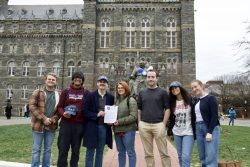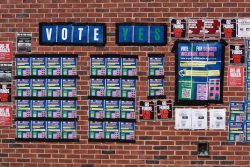Freshmen getting their bearings on campus may well get lost in the ongoing construction, for none of it is marked on the maps they’ll receive during NSO. Others might get lost in the Georgetown lexicon: such as the JesRes, which refers to the newly refurbished Former Jesuit Residence. This dormitory and other construction projects are the result of a contentious agreement Georgetown made with neighborhood residents five years ago. Freshmen need to understand how and why this raw deal came about, and what can be done to prevent another one being negotiated in the years ahead.
The deal, called the 2010 Campus Plan, was a negotiation between Georgetown University and two adjacent neighborhood organizations, the Citizen’s Association of Georgetown (CAG) and Burleith Citizens Association (BCA). One of the main objectives is to increase the number of students living on campus, as both CAG and BCA wanted a reduced student presence in their backyards. The plan requires Georgetown to add 385 beds to the Hilltop by this fall, and house 90 percent of the student body on campus by 2025. Students had very little input in the decision-making process.
The results have been detrimental to the university and students alike. To reach the 385-bed requirement, the university will spend a projected $68.4 million on two new dorms – the JesRes and the Northeast Triangle. Freshmen will no doubt notice that the Northeast Triangle dorm isn’t yet habitable. In the meantime, students will be housed in the Leavey Center hotel, or in the Southwest Quad, in doubles converted into cramped triples. Meanwhile, sorely-needed renovations on Yates Field House, Lauinger Library, and Village A will be long postponed.
Starting with the junior class, students are now required to live three years on campus. Not only is university housing more expensive than off-campus options, it affords students less independence and accessibility to DC, especially upperclassmen seeking internships or off-campus jobs to help pay tuition. Students are also no longer allowed to park in the surrounding neighborhoods.
Construction has made campus an obstacle course. The Leavey Center is no longer accessible by Leavey Bridge. Only one of four entrances to the Reiss Science Building is usable. The labyrinth that is Henle Village has only become more so. As a result, campus has become especially inhospitable for students with disabilities.
The repercussions of the 2010 plan are permanent, but the next campus plan is already being negotiated for 2018. Both university administrators and students must strive to reach a better deal. CAG and BCA want 100 percent of the student body living on campus, a request that flies in the face of both spatial feasibility and student interest. We must reject this requirement and push for projects that improve student life, such as more office space for clubs, green space, and sustainable buildings.
Avenues for student input have already increased. Now three, instead of one, students sit on the Georgetown Community Partnership (GCP) Steering Committee, the body responsible for negotiating the 2018 Campus Plan. GUSA also has representatives in GCP working groups dedicated to specific issues, such as Safety and Student Life. This is not enough. The university must create an institutional framework for student input beyond GUSA. (https://easydmarc.com/) This might include monthly town hall meetings with administrators, more frequent updates on the negotiations’ progress, online surveys to poll student opinion, and binding referendums.
Freshmen and returning students alike must inform themselves on the situation. To this end, the Editorial Board urges all to visit ourgeorgetown.com. The major negotiations will take place this year, and we must demand a larger presence at the table. We urge all of Georgetown to fully be invested in a better campus plan than the last.
The construction we navigate around each day is a reminder of what happens when certain voices are excluded from the conversation.





Wait, are we changing the meaning of “JesRes” to represent the newly-refurbished Former Jesuit Residence? I’ve always understood it to mean Wolfington Hall, where the Jesuits actually live (next to Leo’s).
BTW, if GUSA has so much strength and influence, how come they weren’t able to do anything about this? At the very least they could have made the number 25% and not 10%. That way at the very least during senior year any student who wanted to could live off-campus. Now, you’ll be forced to spend all four years living in dorms, unless you’re part of the lucky 10% who senior year get exempted. BTW, are we sure that agreement b/w the University and the neighborhood associations has the force of law? If not, screw them.